Matty Hong Sends Tommy Caldwell’s Flex Luther—Upgrades to 5.15b.

After three seasons of effort and multiple injuries, Matty Hong has done the long-awaited second ascent of Tommy Caldwell’s Flex Luther, proposing an upgrade to 5.15b.
Hong, 30, is no stranger to hard climbing. In 2017, he became just the fourth American to climb 5.15b (or fifth if Flex Luther was 5.15b when Tommy Caldwell climbed it) with Flight or Flight in Oliana, Spain.
He’s also ticked some of the world’s hardest classics, including La Rambla (5.15a), Joe Mama (5.15a), and Papichulo (5.15a), and he’s done the first ascents of numerous hard 5.14s in Rifle, Colorado, a crag he grew up visiting with his parents.
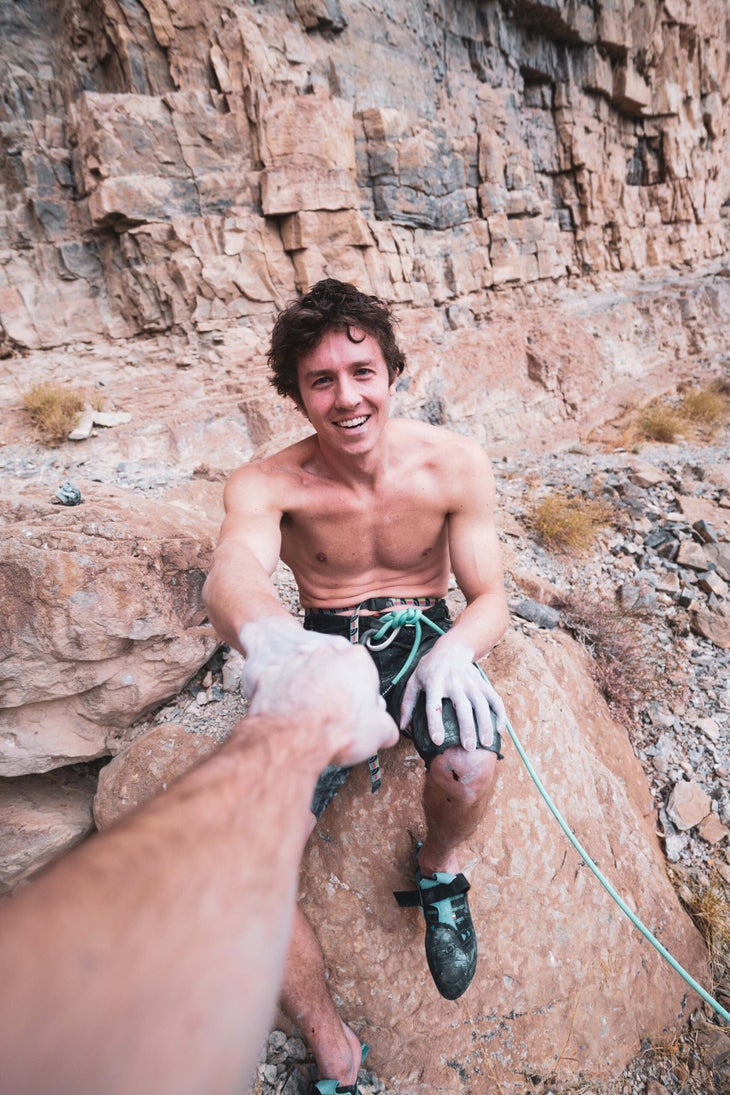
America’s first 5.15
Flex Luther was partially bolted by Nick Sagar in the late 90s, then finished by Tommy Caldwell, who invested weeks into the climb before his accident in November 2001. “It seemed pretty next-level for me,” he told Climbing.
When he lost his finger, Flex Luther became part of a personal litmus test for Caldwell. “It was one of two routes that I made a mission of after I chopped off my finger. If I could do that and the Salathe Wall in the day, then I would have proved to myself that I could still be a rock climber.”
He devoted several months to the climb in the winter of 2002 and 2003, living in a van in the canyon below the cliff. “The canyon is so cold in the winter,” he said. “It was often below zero when we woke up. People have realized now that you can climb with headlamps, but we didn’t know that back then. And the shady hours are so short in the spring and the fall, I just decided that we had to do it in the sun in the winter. The cave [which faces south] is such an oven. The ambient air temperature outside the cave might be in its teens, but we’d be shirtless in the cave.”
When he sent, in January 2003, it was the first proposed 5.15 on American soil and, more importantly, definitive evidence that it would take more than a missing finger to slow Tommy Caldwell down.
Eighteen years unrepeated
After Caldwell sent Flex Luther, and after Tim Kemple wrote an article, published in this magazine in 2005, called “Crag of the Future,” the Fortress of Solitude seemed primed to sit at the center of hard American sport climbing.
“When we first started bolting that thing,” Caldwell said, “it seemed so much bigger and cooler than anything in Rifle.”
But instead—because of the hour-long uphill approach, the difficulty of the routes, and the minimalist cleaning ethic with which the climbs were established—the crag, and Flex Luther especially, went largely untouched for more than a decade. Some of America’s leading sport climbers did brief reconnaissance runs on the route, but nobody invested more than a couple of tries into it, and soon uninspiring rumors about the route’s poor rock quality began to quietly circulate.
“Most of the stories I heard prior to trying it were that holds had broken,” Hong told Climbing, “or that a lot of cleaning needed to be done. I heard that sequences didn’t exist anymore. That certain sections of the route just didn’t go. And to be honest, I kind of put the route aside, thinking that it was no longer a viable climb.”
But then, early in the summer of 2020, while supporting his partner, Margo Hayes, on a neighboring 5.14d, Kryptonite, Hong decided to check the route out for himself. And what he found was that the rumors, though not wrong, had been “exaggerated by time.” There was loose rock, sure, and the route needed cleaning, but he was surprised by how good a lot of the rock was. “There are a couple sections of choss, but that’s just how climbing in Colorado is. The majority of the route is on quite good rock. The crux especially.”
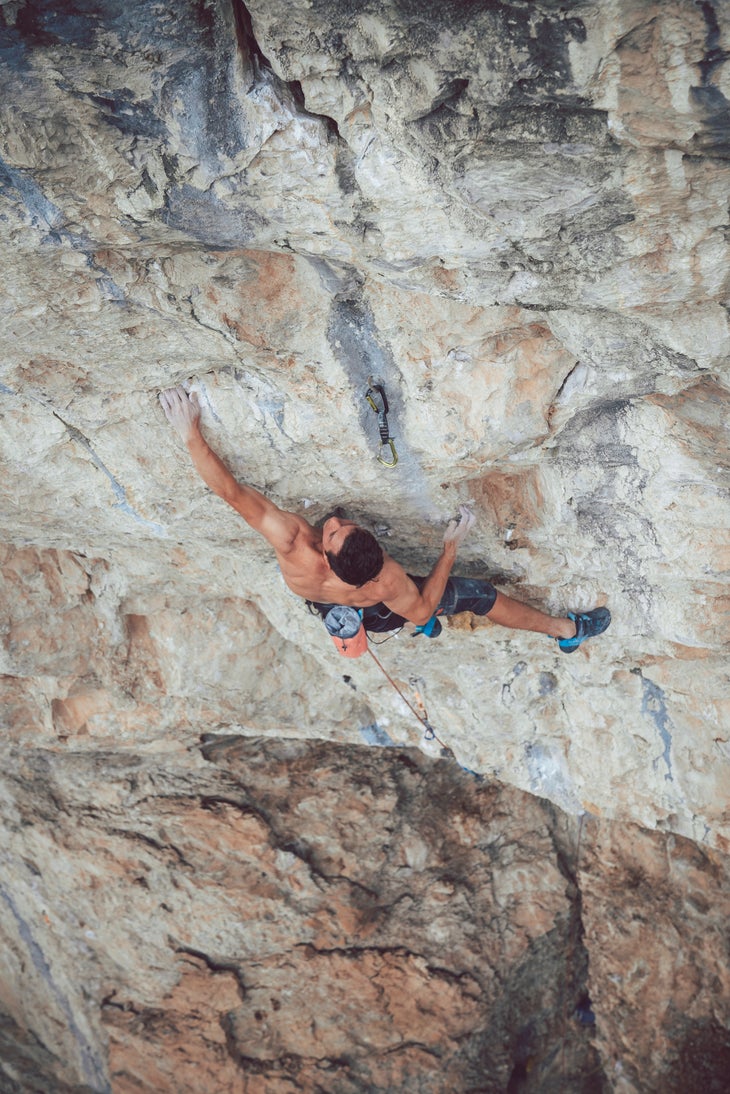
One fact that he was able to confirm: Flex Luther is very, very hard.
At first, Hong was stumped by the crux. “I spent days and days up there just staring at the rock. I couldn’t figure out how to do it. It took me I don’t know how many tries before I finally like unlocked a sequence.”
The route breaks down into four parts, with the first third containing the most difficult movements. The introductory sequence is “intricate and tiring,” with powerful moves through a crack system, and it makes climbing into the V12 crux— which consists of “a really bad kneebar and some big moves off these really terrible pinches” and clocks in around V12— “quite challenging.”
“I would definitely say that climbing through the crux is 5.15a,” Hong said. “Then it’s probably 5.14b to get to the end of the climb. The last boulder problem is V7 or V8.”
The route’s difficulty, however, comes down to endurance rather than power. “It’s amazing how consistent the climbing is. You do a hard move and then, immediately, there’s another complex sequence right above it. It’s stacked with intricate boulder problems with little shakes in between.” It’s a strenuous and stressful style of climbing. “There are a lot of places where you might fall.” The moves are a consistent mixture of hard, insecure, and highly precise. “Lots of big moves, lots of stabbing into pockets.” And the pressure not to mess up mounts as you get higher on the wall. Even the resting positions are stressful. “You’re really just hanging on your fingers with bad feet [and thinking] about all those hard moves ahead of you.”
Two injuries—three seasons
Hayes dispatched Kryptonite in just a few days, so after his initial inspection of the route, Hong waited until October, when it was cooler, before putting consistent effort into Flex. After a month of work, just as real redpoint burns began to seem possible, he was sidelined by a bad ankle sprain. By the time he’d recovered enough to manage the approach, it was winter.
Returning the next spring, he invested another month on the route, battling seeping holds while swapping burns and beta with Carlo Traversi. Toward the end of the season, just as the warmth began impinging on the climbing, Hong had a breakthrough, managing to climb through the lower crux before falling on the last move of the final boulder problem.
But the breakthrough also took its toll on Hong’s body.
“I was on the wall for close to 20 minutes, and I was really desperate. I was fighting. I knew I was going to fall at the end. I knew I was too tired. But I wanted to just get as far as I could.” Hanging on the rope afterward, he realized that he’d injured his shoulder.
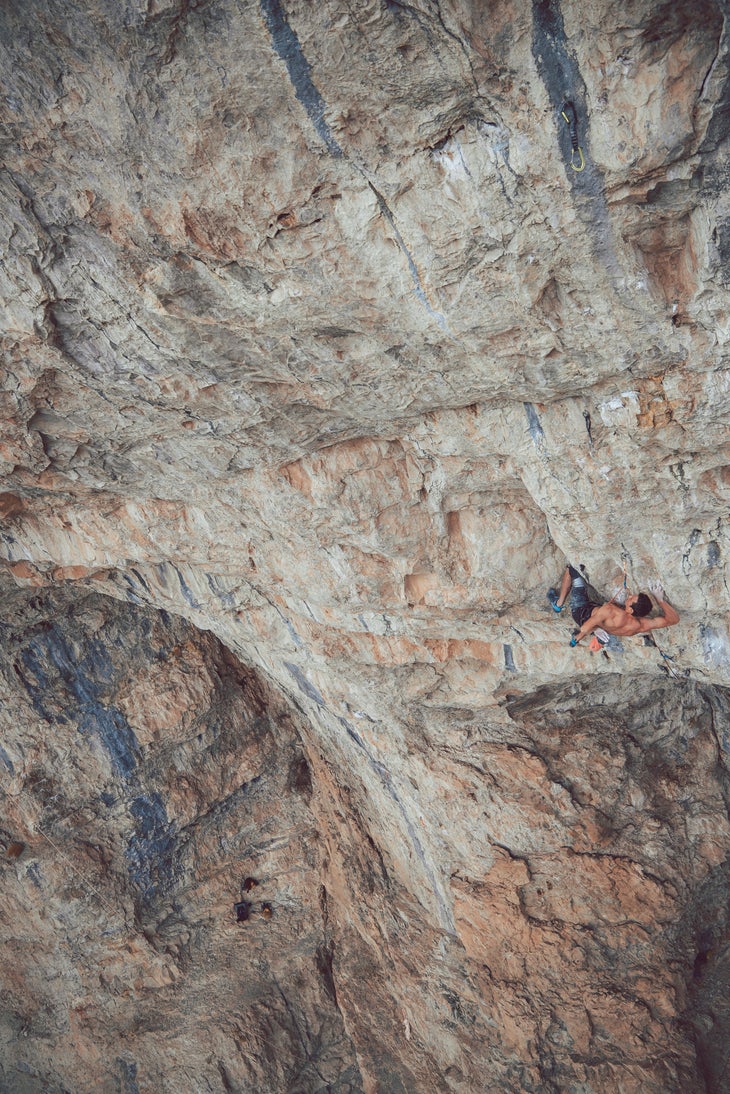
“I still don’t know the full diagnosis,” he said. “But I think I was just exhausting myself to the point where I hurt the muscles. After I fell, I couldn’t raise my arm higher than mid height. I drove home with one hand on the steering wheel. It’s still bothering me, actually. I had some issues this fall, too.”
The injury abruptly ended his chances for the season. He spent the summer recovering, then training, and when he returned to Flex Luther this fall, he was more cautious. But caution only gets you so far. When he broke through the bottom once again (and once again fell on the final move) his shoulder showed signs of flaring up.
“After that I knew it was a ticking time bomb. I knew that if I kept falling on that last move, my body wouldn’t be able to take it and I would likely have to take time off again.”
A hard place to have a long-term project.
“The whole climb, honestly, is pretty stressful for a lot of different reasons,” Hong said. The hike is “pretty burly.” It’s an hour long and steep the whole way. For the last 20 or so minutes, you’re scrambling up a scree field, pulling on fixed ropes. “It’s kind of a brutal location,” he said. But it’s also beautiful. “It’s totally silent up there. There’s nothing, no animals besides a few birds, and there are no people around, and you have this entire cave and this great view—it’s kind of a special little sanctuary up there.”
The easiest good route at The Fortress of Solitude is 5.12. Couple that with the hour-long hike and the fact that Rifle—a roadside mecca—is just half an hour away, and it can be hard to find partners who are willing to go up there to support you. “It’s such a commitment to be up there,” Hong says. Once you’ve secured a belayer and gotten to the cliff, “there’s this pressure to make each try count.”
Hong, supported by Hayes, found himself doing frequent day trips from Boulder. He’d drive three hours, hike an hour, climb for an hour and a half, then drive back to Boulder, where he’d need two full rest days before even considering going back for more.
“It kind of beats you down,” Hong said. “I rarely was able to give it more than one good redpoint attempt per day, especially if I broke through the bottom portion of the route…. it’s such physical and gymnastic climbing.”
He added that Hayes’s support was crucial for him. “I think a lot of sport climbers will understand when I say that having a partner who’s invested in your ascent as much as you are, or at almost as much, can make night and day difference with something like this. So just shout out to her for sticking with me through the good and bad days up there.”
Luckily for his shoulder, Hong sent after only a few days of effort this fall.
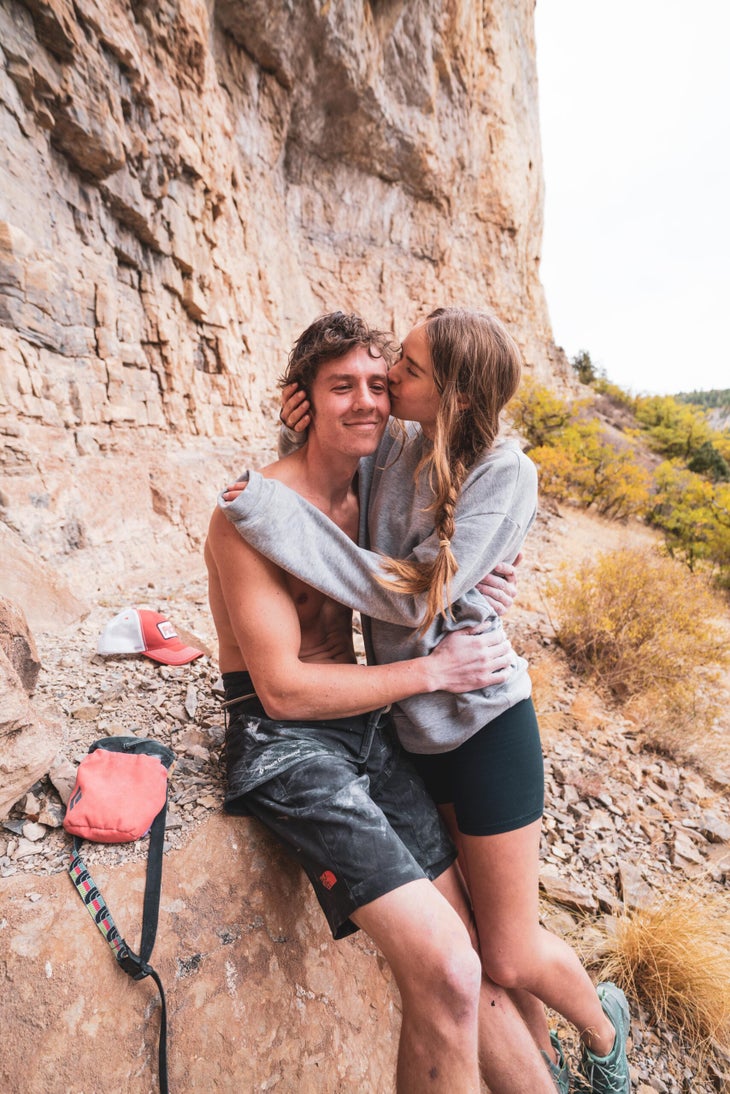
Was Tommy Caldwell the first American to climb 5.15b?
When Hong announced the upgrade on Instagram, certain nerds (myself included) quickly did the math. If Flex Luther was 5.15b when Caldwell sent it (in other words, if the grade wasn’t the product of breaking holds), then Tommy Caldwell, not Chris Sharma, was the first American to climb the grade, and Flex Luther, not Jumbo Love, was the first such climb on American soil.
When I asked Hong what he thought about it, he said that after breaking roughly half a dozen handholds and 20 footholds off the route in his early attempts, he could say with confidence that the climb had changed, though he couldn’t weigh in on how those changes had changed the grade, nor could he measure the impact of the climbers who’d attempted to the climb before him.
“The only person who’s going to know that is Tommy Caldwell,” he said.
When asked whether he might have been the first American to climb 5.15b, Tommy Caldwell was quick to say that whatever Sharma was doing at the time was probably harder. “I wasn’t anywhere near as good of a climber as Chris was,” he said. “So I didn’t think it could be as hard as Chris was climbing.”
Then he added, “But it’s a very weird style, a very Rifle-centric style. I mean you’ve got kneebars, you’ve got handjams, you’ve got to do all this crazy stuff. It’s not just grabbing holds on a steep wall and pulling hard. It’s like crawling up the wall. Almost no holds on the route are actually down pulling.”
Both Caldwell and Hong noted that the story of the climb illustrates how cleaning standards have changed over the years.
Back when Caldwell was establishing the Fortress of Solitude, the ethics were different, Hong said. “Tommy was using a toothbrush to clean his holds—and he was only cleaning the holds he was using.” This left a significant amount of the peripheral rock both dirty and loose—something that, for both aesthetic and safety reasons, most modern route developers remove before opening the route to the public.
Caldwell agreed. “We were kind of rebelling against blatant chipping in place like Buoux and Fontainebleau, the older school areas in Europe,” he said. “Most rock climbing back then was on really good rock. Rifle was one of the first places where people started exploring climbing on choss, where the line between cleaning and chipping is blurred slightly.”
When you’re mostly climbing on really good rock, it made sense to have an “only a toothbrush” mentality; but it doesn’t make as much sense when the rock requires a more hands-on approach. “We believed that everything that came off the route had to come off with just your fingers,” Caldwell said, “and that’s how we developed The Fortress. But the result was that people came back and were like, ‘Man these routes are really dirty, and holds are breaking.’ So it was slightly misguided.”
Hong says that, thanks to the increased traffic, the route has cleaned up nicely. “It’s a great route,” he said, “and it’s going to stay in its current condition for a long time. I haven’t knocked anything off it since the spring.”
Still, Caldwell wants to go back and see how it’s changed. “When I heard Matty did it,” he said, “I started trying to remember the moves from almost 20 years ago, and I think I actually remember most of them. So I think I’d have a pretty good idea. I’m interested to go back and see [what it looks like].”
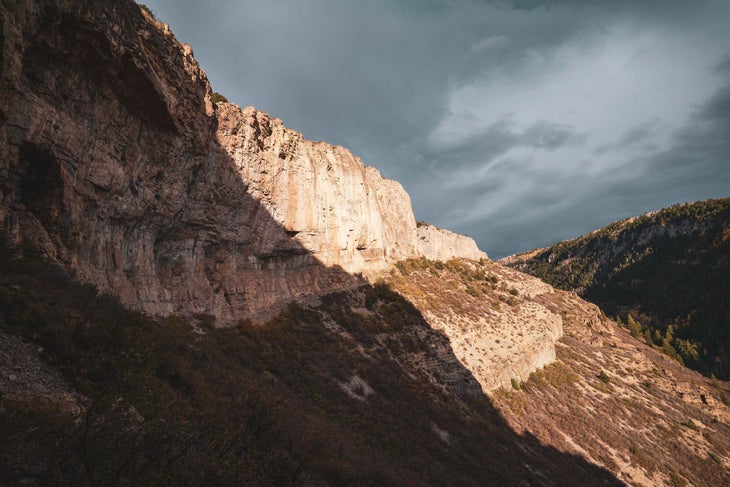
The Crag of the Future
When I asked Hong what was next for him, he said, “Trying Flex Luther for the better part of a year was quite stressful. So right now is a great time for me to kind of step back and look at some other things that I’ve been wanting to do.”
He said was psyched to go back up to the Fortress to take shots of Carlo Traversi, who’s quite close on Flex Luther, and John Cardwell, who’s close on a nearby project, adding that “pursuing photography and film has been really healthy for me…. It can take a toll on you if you’re 100% focused on climbing all the time.”
Almost in the same breath, however, Hong said he was excited to bolt a few more lines for himself up there.
“The potential up that the cliff is amazing,” he said. “There are a lot of really striking lines. I’m excited to bolt something for the remainder of the season and start a new journey on another climb up there.”
We’ll stay tuned.
The post Matty Hong Sends Tommy Caldwell’s Flex Luther—Upgrades to 5.15b. appeared first on Climbing.

